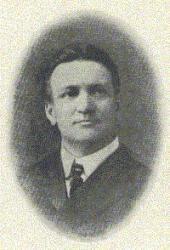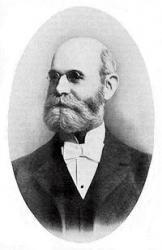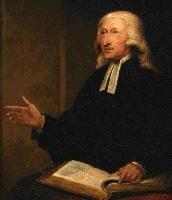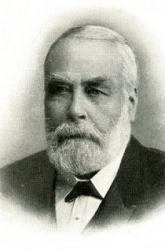Planning worship?
Check out our sister site, ZeteoSearch.org,
for 20+ additional resources related to your search.
- |
User Links
Person Results
P. P. Bilhorn

1865 - 1936 Person Name: Peter P. Bilhorn, 1865-1936 Topics: Peace and Security Author of "Sweet Peace, the Gift of God's Love" in Revival Hymns and Choruses Pseudonyms: W. Ferris Britcher, Irene Durfee; C. Ferris Holden, P. H. Roblin (a anagram of his name)
================
Peter Philip Bilhorn was born, in Mendota, IL. His father died in the Civil War 3 months before he was born. His early life was not easy. At age 8, he had to leave school to help support the family. At age 15, living in Chicago, he had a great singing voice and sang in German beer gardens there. At this time, he and his brother also formed the Eureka Wagon & Carriage Works in Chicago, IL. At 18 Peter became involved in gospel music, studying under George F. Root and George C. Stebbins. He traveled to the Dakotas and spent some time sharing the gospel with cowboys there. He traveled extensively with D. L. Moody, and was Billy Sunday's song leader on evangelistic endeavors. His evangelistic work took him into all the states of the Union, Great Britain, and other foreign countries. In London he conducted a 4000 voice choir in the Crystal Palace, and Queen Victoria invited him to sing in Buckinghm Palace. He wrote some 2000 gospel songs in his lifetime. He also invented a folding portable telescoping pump organ, weighing 16 lbs. It could be set up in about a minute. He used it at revivals in the late 19th century. He founded the Bilhorn Folding Organ Company in Chicago. IL, and his organ was so popular it was sold all over the world. He edited 10 hymnals and published 11 gospel songbooks. He died in Los Angeles, CA, in 1936.
John Perry
P. P. Bilhorn
Cleland Boyd McAfee

1866 - 1944 Person Name: Cleland B. McAfee, 1866-1944 Topics: Peace and Security; Peace and Security Author of "Near to the Heart of God" in Revival Hymns and Choruses Cleland Boyd McAfee (September 25, 1866 – February 4, 1944) was an American theologian, Presbyterian minister and hymn writer, best known for penning the gospel hymn, "Near to the Heart of God," and its tune called "McAfee". He wrote the song after the concurrent deaths of two of his young nieces, caused by diphtheria.
McAfee was born in Ashley Missouri, in 1866, as one of five children. His father, John A. McAfee, was the founder of Park College in Parkville, Missouri. The younger McAfee graduated from Park College in 1884, and later graduated from Union Theological Seminary in New York. McAfee went on to serve as a professor of philosophy, choir director, pastor and dean of Park College until 1901, when he left to minister at the First Presbyterian Church of Chicago. McAfee moved from First Presbyterian in 1904, to pastor the Lafayette Avenue Church of Brooklyn, in Brooklyn, New York. McAfee also taught systematic theology at McCormick Theological Seminary, from 1912 to 1930.
In 1912, McAfee authored the treatise, "The Greatest English Classic: A Study Of The King James Version Of The Bible." He was moderator of the General Assembly of Presbyterian Church in the United States, and led the Presbyterian Board of Foreign Missions from 1930 to 1936. He died in 1944.
On August 10, 1892, McAfee married Harriet "Hattie" Lawson Brown; they had three children, Ruth Myrtle, Katharine Agnes, and Mildred Helen. Mildred Helen McAfee Horton went on to become the first director of WAVES (Women Accepted for Volunteer Emergency Service) in the United States Navy.
--en.wikipedia.org/wiki/Cleland_Boyd_McAfee
Cleland Boyd McAfee
W. D. Cornell

1858 - 1936 Person Name: W. D. Cornell, 19th century Topics: Peace and Security Author of "Wonderful Peace" in Revival Hymns and Choruses Rv Warren Donald Cornell USA 1858-1936. Born in Whiteford, MI, he trained as a school teacher and began teaching in Dallas Public Schools at age 19. Licensed by the Southern Methodist conference in 1879, he was appointed to preach in Denton and Gainesville, TX, for a year in each place. He married Jennie Estelle Roberts in 1880, and they five sons: Warren, Louis, William, Robert, and Donald, and a daughter, Florence. In 1881 he removed to the Oshkosh, WI, area and spent most of his career preaching at various pastorates and in Berlin, WI. He was an eloquent precher, poet, and evangelist. In 1894 he became minister of the People's Christian Assn., in Fond du Lac, WI. The group met for 10 years and disbanded. Cornell pastored an independent church there. In 1905, after pastoring, he entered real estate. He took an interest in political and social issues, and became secretary of the Paving Cutter's Union, and leader of the 'Anti-Tramp Society”. He became a lecturer, and a founding member of the anti-socialist Constitutional Defense League, spending much of his time in this cause. He was no longer a member of clergy, but a touring lecturer for several years. By 1925 he and his family had moved to NY state, where he eventually died. He was buried in Fond du Lac, WI.
John Perry
W. D. Cornell
Mrs. C. H. Morris

1862 - 1929 Person Name: Lelia N. Morris, 1862-1929 Topics: Peace and Security Author of "Nearer, Still Nearer" in Revival Hymns and Choruses Lelia (Mrs. C.H.) Morris (1862-1929) was born in Pennsville, Morgan County, Ohio. When her family moved to Malta on the Muskingum River she and her sister and mother had a millinery shop in McConnelsville. She and her husband Charles H. Morris were active in the Methodist Episcopal Church and at the camp meetings in Sebring and Mt. Vernon. She wrote hymns as she did her housework. Although she became blind at age 52 she continued to write hymns on a 28-foot long blackboard that her family had built for her. She is said to have written 1000 texts and many tunes including "Sweeter as the years go by."
Mary Louise VanDyke
Mrs. C. H. Morris
Norman E. Johnson
1928 - 1983 Person Name: Norman Johnson, 1928- Topics: Peace and Security Arranger of "RHONDDA" in Revival Hymns and Choruses
Norman E. Johnson
William J. Kirkpatrick

1838 - 1921 Person Name: William J. Kirkpatrick, 1838-1921 Topics: Peace and Security Composer of "[A wonderful Savior is Jesus my Lord]" in Revival Hymns and Choruses William J. Kirkpatrick (b. Duncannon, PA, 1838; d. Philadelphia, PA, 1921) received his musical training from his father and several other private teachers. A carpenter by trade, he engaged in the furniture business from 1862 to 1878. He left that profession to dedicate his life to music, serving as music director at Grace Methodist Church in Philadelphia. Kirkpatrick compiled some one hundred gospel song collections; his first, Devotional Melodies (1859), was published when he was only twenty-one years old. Many of these collections were first published by the John Hood Company and later by Kirkpatrick's own Praise Publishing Company, both in Philadelphia.
Bert Polman
William J. Kirkpatrick
Ira David Sankey

1840 - 1908 Person Name: Ira D. Sankey, 1840-1908 Topics: Peace and Security Composer of "[The Lord's our Rock, in Him we hide]" in Revival Hymns and Choruses Sankey, Ira David, was born in Edinburgh, Pennsylvania, in 1840, of Methodist parents. About 1856 he removed with his parents to New Castle, Pennsylvania, where he became a member of the Methodist Episcopal Church. Four years afterwards he became the Superintendent of a large Sunday School in which he commenced his career of singing sacred songs and solos. Mr. Moody met with him and heard him sing at the International Convention of the Young Men's Christian Association, at Indianapolis, and through Mr. Moody's persuasion he joined him in his work at Chicago. After some two or three years' work in Chicago, they sailed for England on June 7, 1872, and held their first meeting at York a short time afterwards, only eight persons being present. Their subsequent work in Great Britain and America is well known.
Mr. Sankey's special duty was the singing of sacred songs and solos at religious gatherings, a practice which was in use in America for some time before he adopted it. His volume of Sacred Songs and Solos is a compilation from various sources, mainly American and mostly in use before. Although known as Sankey and Moody’s Songs, only one song, "Home at last, thy labour done" is by Mr. Sankey, and not one is by Mr. Moody. Mr. Sankey supplied several of the melodies. The English edition of the Sacred Songs & Solos has had an enormous sale; and the work as a whole is very popular for Home Mission services. The Songs have been translated into several languages.
--John Julian, Dictionary of Hymnology (1907)
Pseudonymns:
Harry S. Lower
Rian A. Dykes
====================
Sankey, I. D., p. 994, i. During the past fifteen years Mr. Sankey's Sacred Songs and Solos have had a very large sale, which has justified him in increasing the number of songs and hymns, including " New Hymns and Solos," to 1200. In 1906 he published My Life and Sacred Songs (London : Morgan & Scott). In addition to the "Story of his Own Life," the work contains an account of the most popular of his solos, with interesting reminiscences of the spiritual awakening of many who were influenced through his singing of them in public. In this respect it corresponds in some measure with G. J. Stevenson's Methodist Hymn Book, &c, 1883 (p. 1094, i.). It is an addition to the Sacred Songs and Solos, which will be held in esteem by many. In addition to his hymn, noted on p. 994, ii., Mr. Sankey gives details of the following:—
1. Out of the shadow-land into the sunshine. [Heaven Anticipated.] Mr. Sankey's account of this hymn is:—
"I wrote this hymn specially for the memorial service held for Mr. Moody in Carnegie Hall, where 1 also sang it as a solo. It is the last sacred song of which I wrote both the words and music. The idea was suggested by Mr. Moody's last words, 'Earth recedes; heaven opens before me . . . God is calling me, and I must go.' On account of its peculiar association with my fellow-labourer in the Gospel for so many years, the words are here given in full."
The hymn follows on p. 185, in 3 stanzas of 4 lines and a chorus.
2. Rejoice! Rejoice! our King is coming, [Advent.] Mr. Sankey writes concerning this hymn:—
"During one of my trips to Great Britain on the SS. City of Rome a storm raged on the sea. The wind was howling through the rigging, and waves like mountains of foam were breaking over the bow of the vessel. A great fear had fallen upon the passengers. When the storm was at its worst, we all thought we might soon go to the bottom of the sea. The conviction came to me that the Lord would be with us iu the trying hour, and sitting down in the reading room, I composed this hymn. Before reaching England the tune had formed itself in my mind, and on arriving in London I wrote it out, and had it published in Sacred Songs and Solos, where it is No. 524 in the edition. of 1888.
From Mr. Sankey's autobiographical sketch we gather that he was born at Edinburgh, in Western Pennsylvania, Aug. 28, 1840, joined Mr. Moody in 1871, and visited England for the first time in 1873. The original of the Sacred Songs, &c, of 23 pieces only, was offered as a gift to the London publishers of P. Phillips's Hallowed Song, and declined by them. It was subsequently accepted by Mr. K. O. Morgan, of Morgan & Scott, and is now a volume of 1200 hymns.
From a return kindly sent us by Messrs. Morgan & Scott, we find that the various issues of the Sacred Songs and Solos were:—
In 1873, 24 pp.; 1874, 72 pp. ; 1876, 153 hymns; 1877, 271 hymns; 1881, 441 hymns; 1888, 750 hymns; 1903, 1200 hymns.
In addition, The Christian Choir, which is generally associated with the Sacred Songs and Solos, was issued in 1884 with 75 hymns, and in 1896 with 281. The New Hymns & Solos, by the same firm, were published in 1888.
--John Julian, Dictionary of Hymnology, New Supplement (1907)
Ira David Sankey
John Wesley

1703 - 1791 Person Name: John Wesley, 1703-1791 Topics: Peace and Security Alterer of "Before Jehovah's Aweful Throne" in Revival Hymns and Choruses John Wesley, the son of Samuel, and brother of Charles Wesley, was born at Epworth, June 17, 1703. He was educated at the Charterhouse, London, and at Christ Church, Oxford. He became a Fellow of Lincoln College, Oxford, and graduated M.A. in 1726. At Oxford, he was one of the small band consisting of George Whitefield, Hames Hervey, Charles Wesley, and a few others, who were even then known for their piety; they were deridingly called "Methodists." After his ordination he went, in 1735, on a mission to Georgia. The mission was not successful, and he returned to England in 1738. From that time, his life was one of great labour, preaching the Gospel, and publishing his commentaries and other theological works. He died in London, in 1791, in his eighty-eighth year. His prose works are very numerous, but he did not write many useful hymns. It is to him, however, and not to his brother Charles, that we are indebted for the translations from the German.
--Annotations of the Hymnal, Charles Hutchins, M.A., 1872
======================
John Wesley, M.A., was born at Epworth Rectory in 1703, and, like the rest of the family, received his early education from his mother. He narrowly escaped perishing in the fire which destroyed the rectory house in 1709, and his deliverance made a life-long impression upon him. In 1714 he was nominated on the foundation of Charterhouse by his father's patron, the Duke of Buckingham, and remained at that school until 1720, when he went up, with a scholarship, from Charterhouse to Christ Church, Oxford. Having taken his degree, he received Holy Orders from the Bishop of Oxford (Dr. Potter) in 1725. In 1726 he was elected Fellow of Lincoln College, and remained at Oxford until 1727, when he returned into Lincolnshire to assist his father as curate at Epworth and Wroot. In 1729 he was summoned back to Oxford by his firm friend, Dr. Morley, Rector of Lincoln, to assist in the College tuition. There he found already established the little band of "Oxford Methodists" who immediately placed themselves under his direction. In 1735 he went, as a Missionary of the Society for the Propagation of the Gospel, to Georgia, where a new colony had been founded under the governorship of General Oglethorpe. On his voyage out he was deeply impressed with the piety and Christian courage of some German fellow travellers, Moravians. During his short ministry in Georgia he met with many discouragements, and returned home saddened and dissatisfied both with himself and his work; but in London he again fell in with the Moravians, especially with Peter Bohler; and one memorable night (May 24, 1738) he went to a meeting in Aldersgate Street, where some one was reading Luther's preface to the Epistle to the Romans. There, "About a quarter before nine, while he was describing the change which God works in the heart through faith in Christ, I felt my heart strangely warmed. I felt I did trust in Christ, Christ alone, for salvation; and an assurance was given me, that He had taken away my sins, even mine, and saved me from the law of sin and death." From that moment his future course was sealed; and for more than half a century he laboured, through evil report and good report, to spread what he believed to be the everlasting Gospel, travelling more miles, preaching more sermons, publishing more books of a practical sort, and making more converts than any man of his day, or perhaps of any day, and dying at last, March 2, 1791, in harness, at the patriarchal age of 88.
The popular conception of the division of labour between the two brothers in the Revival, is that John was the preacher, and Charles the hymnwriter. But this is not strictly accurate. On the one hand Charles was also a great preacher, second only to his brother and George Whitefield in the effects which he produced. On the other hand, John by no means relegated to Charles the exclusive task of supplying the people with their hymns. John Wesley was not the sort of man to depute any part of his work entirely to another: and this part was, in his opinion, one of vital importance. With that wonderful instinct for gauging the popular mind, which was one element in his success, he saw at once that hymns might be utilized, not only for raising the devotion, but also for instructing, and establishing the faith of his disciples. He intended the hymns to be not merely a constituent part of public worship, but also a kind of creed in verse. They were to be "a body of experimental and practical divinity." "In what other publication," he asks in his Preface to the Wesleyan Hymn Book, 1780 (Preface, Oct. 20,1779), "have you so distinct and full an account of Scriptural Christianity; such a declaration of the heights and depths of religion, speculative and practical; so strong cautions against the most plausible errors, particularly those now most prevalent; and so clear directions for making your calling and election sure; for perfecting holiness in the fear of God?" The part which he actually took in writing the hymns, it is not easy to ascertain; but it is certain that more than thirty translations from the German, French and Spanish (chiefly from the German) were exclusively his; and there are some original hymns, admittedly his composition, which are not unworthy to stand by the side of his brother's. His translations from the German especially have had a wide circulation. Although somewhat free as translations they embody the fire and energy of the originals.
It has been the common practice, however for a hundred years or more to ascribe all translations from the German to John Wesley, as he only of the two brothers knew that language; and to assign to Charles Wesley all the original hymns except such as are traceable to John Wesley through his Journals and other works.
The list of 482 original hymns by John and Charles Wesley listed in this Dictionary of Hymnology have formed an important part of Methodist hymnody and show the enormous influence of the Wesleys on the English hymnody of the nineteenth century.
-- Excerpts from John Julian, Dictionary of Hymnology (1907)
===================
See also in:
Hymn Writers of the Church
John Wesley
C. Austin Miles

1868 - 1946 Person Name: C. A. M. Topics: Peace and Security Author of "Dwelling in Beulah Land" in Revival Hymns and Choruses Charles Austin Miles USA 1868-1946. Born at Lakehurst, NJ, he attended the Philadelphia College of Pharmacy and the University of PA. He became a pharmacist. He married Bertha H Haagen, and they had two sons: Charles and Russell. In 1892 he abandoned his pharmacy career and began writing gospel songs. At first he furnished compositions to the Hall-Mack Publishing Company, but soon became editor and manager, where he worked for 37 years. He felt he was serving God better in the gospel song writing business, than as a pharmacist. He published the following song books: “New songs of the gospel” (1900), “The service of praise” (1900), “The voice of praise” (1904), “The tribute of song” (1904), “New songs of the gospel #2” (1905), “Songs of service” (1910), “Ideal Sunday school hymns” (1912). He wrote and/or composed 400+ hymns. He died in Philadelphia, PA.
John Perry
C. Austin Miles
Vernon J. Charlesworth

1838 - 1915 Person Name: Vernon J. Charlesworth, 1838-? Topics: Peace and Security Author of "A Shelter in the Time of Storm" in Revival Hymns and Choruses Charlesworth, Vernon J. , was born at Barking, Essex, on April 28, 1839, and educated at Homerton College. In 1864 he became co-pastor with the Rev. Newman Hall at the old Surrey Chapel, and in 1869 the Head Master of Mr. Spurgeon's Stockwell Orphan¬age. Mr. Charlesworth has published The Life of Rowland Hill, &c, 1876, and, in co-operation with Mr. J. Manton Smith, Flowers and Fruits of Sacred Song and Evangelistic Hymns. To this work he contributed:—
1. As you gather round the family board. Plea for Orphans.
2. Blessed Jesus, Lord and Master. Conferences.
3. Come, brethren, let us sing. Praise to God.
4. Come to Jesus, He invites you. Invitation.
5. Heart to heart by love united. Holy Matrimony.
6. How blest in Jesus' name to meet. Praise to Jesus.
7. Our lamps are gone out, and the daylight is past. The Foolish Virgins.
8. Sweetest fellowship we know. Walking in the Light.
9. The day of the Lord is at hand. Advent.
10. There is a land as yet unknown. Heaven.
11. 'Tis a blessed thing while we live to sing. Praise.
12. When far from Thee, and heirs of woe. Grace.
13. Ye servants of Jesus, go forth. Missions.
In addition to these hymns, Mr. Charlesworth contributed—
14. I've nothing to bring Thee, Jesus. Lent.
to Fullerton & Smith's Evangelical Echoes, 1884, and has printed a considerable number as leaflets. Two of the most recent, "As the eastern hills are glowing" (Morning), and "Lengthening shadows darkly falling" (Evening), should find their way into common use. Mr. Charlesworth's hymns are very spirited and of a popular character.
--John Julian, Dictionary of Hymnology (1907)
Vernon J. Charlesworth


 My Starred Hymns
My Starred Hymns

